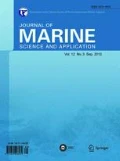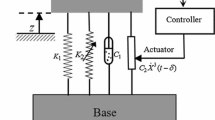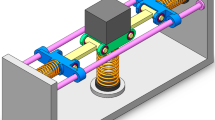Abstract
Motivated by the need for improving the isolation performance, many research studies have been performed on isolators with nonlinear characteristics. Based on the shape of their phase portrait, such devices can be configured as either a mono- or bi-stable isolator. This paper focuses on investigating the relative performance of these two classes under the same excitations. Force transmissibility is used to measure the isolation performance, which is defined in terms of the RMS of the ratio of the transmitted force to the excitation force. When the system is subjected to harmonic excitation, it is found that the maximum reduction of the force transmissibility in the isolation range using Quasi-Zero stiffness is achieved. When the system is subjected to random excitation, it has the same effect of Quasi-Zero stiffness. Further, optimum damping can be changed with stiffness and has minimum value.
Similar content being viewed by others
References
Alabuzhev P, Gritchin A, Kim L, Migirenko G, Chon V, Stepanov P (1989). Vibration protecting and measuring systems with quasi-zero stiffness. Hemisphere Publishing, New York.
Carrella A, Brennan MJ, Waters TP (2007). Static analysis of a passive vibration isolator with quasi-zero stiffness characteristic. Journal of Sound and Vibration, 301(3–5), 678–689.
Carrella A, Brennan MJ, Kovacic I, Waters TP (2009). On the force transmissibility of a vibration isolator with quasi-zero-stiffness. Journal of Sound and Vibration, 322(4–5), 707–717.
Carrella A, Brennan MJ, Waters TP, Lopes Jr. V (2012). Force and displacement transmissibility of a nonlinear isolator with high-static-low-dynamic-stiffness. International Journal of Mechanical Sciences, 55(1), 22–29.
Ibrahim RA (2008). Recent advances in nonlinear passive vibration isolators. Journal of Sound and Vibration, 314(3–5), 371–452.
Kloeden PE, Platen E (1992). numerical solutions of stochastic differential equations. Springer, Berlin.
Le TD, Ahh KK (2011). A viration isolation system in low frequency excitation region using negative stiffness structure for vehicle seat. Journal of Sound and Vibration, 330(26), 6311–6335.
Lu C, Bai H (2011). A new type nonlinear ultra-low frequency passive vibration isolation system. Journal of Vibration and Shock, 30(1), 234–236.
Lu Z, Brennan MJ, Yang T, Li X, Liu Z (2013). An investigation of a two-stage nonlinear vibration isolation system. Journal of Sound and Vibration, 322(4–5), 1456–1464.
Mann BP, Owens BA (2013). Investigations of a nonlinear energy harvester with a bistable potential well. Journal of Sound and Vibration, 329(9), 1215–1226.
Mead DJ (1998). Passive vibration control. Wiley, NY.
Pellegrini SP, Tolou N, Schenk M, Herder JL (2012). Bistable vibration energy harvesrers: A review. Journal of Intelligent Material Systems and Structures, 24(11), 1303–1312.
Piersol AG, Paez TL (2009). Harris’ Shock and vibration handbook 6th edition. McGraw-Hill, New York.
Rivin EI (2003). Passive vibration isolation. American Society of Mechanical Engineers Press, New York.
Robertson WS, Kidner MRF, Cazzolato BS, Zander AC (2009). Theoretical design parameters for a quasi-zero stiffness magnetic spring for vibration isolation. Journal of Sound and Vibration, 326(1), 88–103.
Shaw A, Neild S, Wagg D, Weaver P, Carrella A (2013). A nonlinear spring mechanism incorporating a bistable composite plate for vibration isolation. Journal of Sound and Vibration, 332(24), 6265–6275.
Tang B, Brennan MJ (2013). A comparison of two nonlinear damping mechanisms in a vibration isolator. Journal of Sound and Vibration, 332(2), 510–520.
Vanden-Eijnden E, Ciccotti G (2006). Second-order integrators for Langevin equations with holonomic constraints. Chemical Physics Letters, 429, 310–316.
Xiao Z, Jing X, Cheng L (2013). The transmissibility of vibration isolators with cubic nonlinear damping under both force and base excitations. Journal of Sound and Vibration, 332(5), 1335–1354.
Yang K, Harne RL, Wang KW, Huang H (2014). Investigation of a bistable dual-stage vibration isolator under harmonic excitation. Smart Materials and Structures, 23(4), 045033.
Author information
Authors and Affiliations
Corresponding author
Additional information
Foundation item: Supported by the National Natural Science Foundation of China (No. 51375103).
Zeqi Lu was born in 1985. He is a PhD candidate at Harbin Engineering University. He has presented one paper at an international conference and has one paper published in the Journal of Sound and Vibration. His current research interest is improved passive vibration isolation using nonlinear mechanisms.
Tiejun Yang was born in Hunan, China in 1972. He received a BSc, MSc in Diesel Engineering and a PhD in Marine Engineering from Harbin Engineering University in 1994, 1997 and 2001, respectively, and then became a postdoctoral researcher at the National Key Laboratory of Rotorcraft and Aeromechanics, Nanjing University of Aeronautics and Astronautics. From 2006 through 2007, he worked at the Dynamic Group of the Institute of Sound and Vibration Research at Southampton University in UK. Now he is a professor at the Power and Energy Engineering College, Harbin Engineering University. He is a member of the Acoustic Society of America, International Institute of Acoustics and Vibration, American Society of Mechanical Engineers. He has published over 70 journal and conference papers regarding vibration and noise control. His research interests include noise and vibration control, active vibration and noise control, and nonlinear vibration.
Michael J. Brennan graduated from the Open University while he was serving in the Royal Navy. He received an MSc in Sound and Vibration Studies and a PhD in the active control of vibration, both from the University of Southampton, United Kingdom. He is a retired Professor of Engineering Dynamics at the Institute of Sound and Vibration Research (ISVR), the University of Southampton, UK, and is currently a Visiting Professor at UNESP, Ilha Solteira in Brazil. He is a past President of the European Association of Structural Dynamics, Associate Editor of the Transactions of the ASME Journal of Vibration and Acoustics and Guest Professor at Harbin Engineering University in China. He has a wide range of research interests, encompassing active and passive control of vibration, acoustics, vibroacoustics and rotor dynamics.
Zhigang Liu was born in Shandong, China in 1956. He received his BS and MS degrees from Harbin Ship Engineering Institute in 1981 and 1987 respectively, and then received a PhD degree from Harbin Engineering University in 2000. Now he is the president of Harbin Engineering University and a professor and supervisor for PhD students. He is the vice-chairman of the Shipbuilding Industry Association of China, the Chinese Society of Naval Architects and Marine Engineers, the Science and Technology Association of Heilongjiang Province. He is also the executive director of Nuclear Industry Association of China and the Internal Combustion Engine Institute of China. He has authored and co-authored more than 100 journal and conference papers, one monograph on active vibration control of marine diesel. His main research interests include vibration and noise control, diesel dynamics, etc.
Rights and permissions
About this article
Cite this article
Lu, Z., Yang, T., Brennan, M.J. et al. An investigation into the isolation performance of mono-and bi-stable systems. J. Marine. Sci. Appl. 13, 291–298 (2014). https://doi.org/10.1007/s11804-014-1259-5
Received:
Accepted:
Published:
Issue Date:
DOI: https://doi.org/10.1007/s11804-014-1259-5




